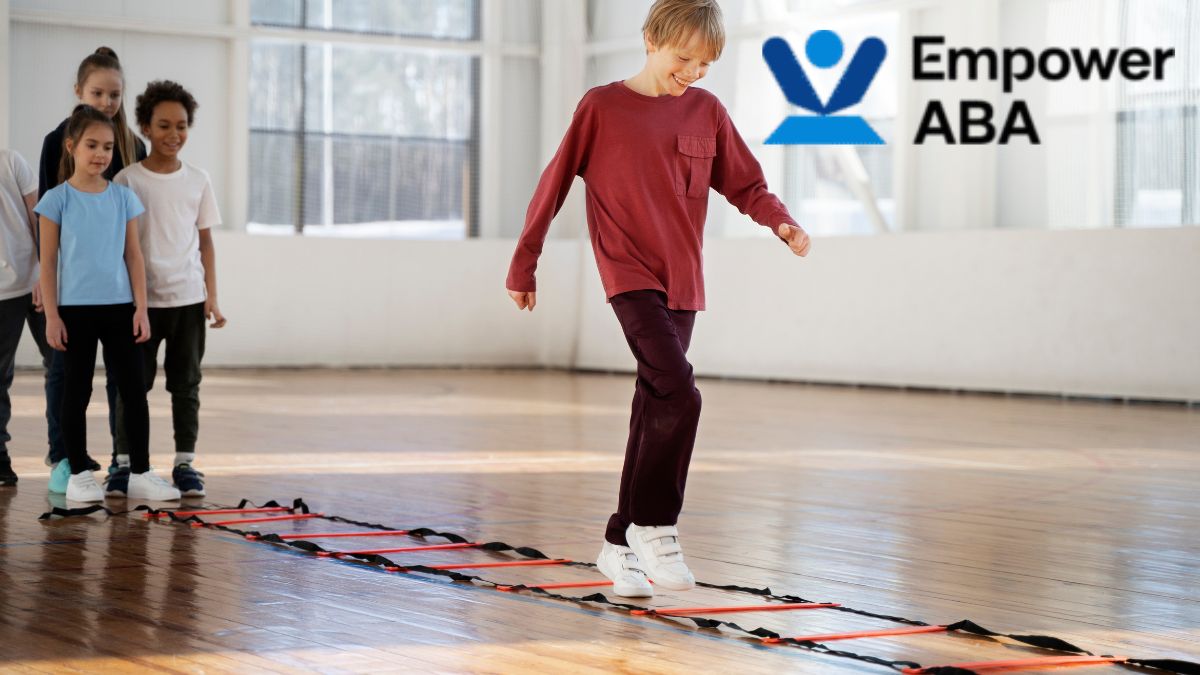Key Points:
- Sensory integration therapy helps children with autism handle sounds, touch, or movement more calmly.
- Through fun, structured play, children boost focus and coordination.
- Pairing therapy with sensory-friendly spaces helps children grow socially and emotionally.
Many children with autism experience the world in ways that can feel overwhelming. Sensory integration therapy autism is a structured approach designed to help them process sensory input more effectively. This therapy targets challenges with touch, movement, sound, sight, taste, and body awareness. It offers playful, engaging methods to help children navigate daily routines, from eating and dressing to socializing and learning.
Think of a child who flinches at a vacuum or avoids certain textures. With sensory integration therapy, children can learn to tolerate these experiences, respond calmly, and sometimes even enjoy them. By addressing sensory differences early, children gain confidence, independence, and a sense of calm that carries into every part of their lives.
What is Sensory Integration Therapy?

Sensory integration therapy (SIT) is a clinical, play-based approach that helps children interpret sensory input from their environment. Occupational therapists design activities that challenge the child’s sensory systems while keeping them engaged and motivated. The goal is to improve the brain’s ability to organize sensations, which in turn enhances daily functioning.
Key principles include:
- Child-directed play: Activities are chosen based on what engages the child.
- ‘Just-right’ challenge: Tasks are difficult enough to promote growth without causing frustration.
- Active engagement: The child is fully involved, not a passive participant.
- Therapist–child relationship: Positive interactions support learning and trust.
According to Schaaf et al. (2013), children who received SIT alongside usual care demonstrated significant improvement in daily activities compared with children who received only standard therapies.
Core Sensory Systems Targeted
SIT focuses on three primary systems essential for everyday life: tactile, vestibular, and proprioceptive. These systems develop before birth and continue refining through childhood. Dysfunction can lead to sensory challenges affecting behavior, coordination, and learning.
| Sensory System | Function | Signs of Dysfunction | SIT Approach |
| Tactile | Sense of touch, pressure, temperature | Avoiding textures, resisting grooming, withdrawing from touch | Finger painting, tactile toys, deep pressure activities |
| Vestibular | Balance, spatial orientation | Fear of movement, seeking spinning or jumping | Swings, rocking, balance exercises |
| Proprioceptive | Body awareness, motor control | Clumsiness, poor posture, difficulty with tasks like writing | Heavy work, pushing/pulling activities, obstacle courses |
By addressing these systems, children gain improved coordination, attention, and emotional regulation.
Benefits of Sensory Integration Therapy for Autism

SIT can produce noticeable changes in children’s lives, particularly in their ability to engage with the environment. Research and clinical observations highlight these benefits:
- Improved sensory processing: Children learn to receive, interpret, and respond to sensory information more effectively. Studies show improvements in attention and adaptive behavior following consistent SIT sessions (Randell et al., 2022).
- Enhanced emotional regulation: Reducing hypersensitivity or sensory-seeking behaviors leads to calmer reactions to daily experiences.
- Motor skills development: Activities improve fine and gross motor coordination, strengthening body awareness and planning skills.
- Better social engagement: Children can tolerate social and classroom settings more easily, promoting participation and interaction.
- Reduced challenging behaviors: Anxiety and sensory overload often decrease, leading to fewer meltdowns and better coping strategies.
Children receiving sensory integration therapy alongside standard therapies often need less assistance with daily tasks compared to those who do not receive it.
Common Sensory Integration Techniques
Therapists use specific techniques to target sensory processing challenges. These techniques can be adapted to each child’s needs and often overlap to provide multi-sensory experiences.
1. Deep Pressure Therapy
- Uses weighted blankets, tight hugs, or compression vests.
- Calms the nervous system, reduces anxiety, and promotes focus.
2. Proprioceptive Activities
- Pushing, pulling, lifting, or carrying objects.
- Improves body awareness, coordination, and motor planning.
3. Vestibular Stimulation
- Swinging, rocking, or spinning.
- Enhances balance, spatial awareness, and coordination.
4. Tactile Stimulation
- Finger painting, textured toys, sand, or rice bins.
- Desensitizes hypersensitivity or increases tolerance for touch.
5. Visual Stimulation
- Visual schedules, timers, or color-coded cues.
- Helps organize and interpret visual information, reducing overload.
6. Auditory Stimulation
- Calming music or rhythmic instruments.
- Supports auditory processing and decreases sound sensitivity.
7. Oral Stimulation
- Chewy toys, straws, or oral motor exercises.
- Improves feeding skills and oral regulation.
Each technique can be woven into play to keep children motivated and engaged while promoting real-world improvements.
Creating a Sensory-Friendly Environment
A supportive environment enhances the benefits of SIT by reducing overstimulation and providing opportunities for self-regulation.
Designing Physical Space
- Sensory Zones: Quiet corner, movement area, sensory play space.
- Lighting: Adjustable lights and natural light for calmness.
- Color Palette: Soft, neutral colors minimize visual stress.
- Visual Organization: Use labels, charts, and schedules to clarify expectations.
Sensory Tools and Equipment
| Tool | Benefit |
| Weighted blankets | Deep pressure, calming effect |
| Fidget toys | Reduce anxiety, increase focus |
| Sensory swings | Vestibular input, body movement |
| Noise-canceling headphones | Reduce auditory overload |
Establishing Routines
- Sensory Breaks: Regularly scheduled moments for self-regulation.
- Transition Strategies: Visual schedules or timers aid smooth changes.
- Sensory Diets: Personalized plans of sensory activities throughout the day.
Creating a predictable, structured environment allows children to experience therapy’s benefits more fully.
Incorporating Sensory Integration in Daily Life
SIT is not limited to therapy sessions. Embedding techniques into home, school, and community settings helps children generalize skills and build confidence.
Home Activities
- Sensory Bins: Rice, sand, or beans for tactile exploration.
- Obstacle Courses: Soft mats, low beams, and balance ropes to encourage physical movement and improve motor skills.
- Weighted Blankets or Deep Pressure: Calm overstimulation.
- Nature Walks: Visiting sensory-friendly trails allows visitors to touch plant textures, listen to birdsong, and feel tree bark, enhancing sensory experiences.
School Strategies
- Sensory Breaks: A school might provide a quiet room where students can take a break with soft music and fidget tools to reset before returning to class.
- Flexible Seating: Therapy balls or wobble chairs for active engagement.
- Visual Supports: Timers, charts, or social stories reduce anxiety.
Community Supports
- Sensory-Friendly Outings: Venues may offer reduced noise levels and lighting adjustments, such as dimming lights or designating special quiet hours with fewer visitors and softer sounds.
- Preparation: Discussing the outing’s schedule beforehand can help alleviate anxiety.
- Tools: Noise-cancelling headphones, sunglasses, or lap pads help manage sensory input.
By integrating therapy techniques across settings, children practice skills in real-world situations, improving independence and participation.
Evidence and Research
Recent studies provide growing support for SIT:
- SenITA RCT (2022): Demonstrated that children receiving SIT improved goal attainment, functional outcomes, and behavioral responses compared with controls.
- Case-Smith et al., 2015: Found that SIT enhances adaptive responses to sensory experiences in children with autism, though sample sizes were small.
- (Fazlioğlu & Baran, 2007): A study on sensory integration therapy for children with autism showed positive effects on sensory issues, with significant improvements after therapy.
While research continues, evidence suggests SIT supports practical improvements in sensory processing, motor skills, and daily life engagement.
FAQs
1. How can I tell if my child needs sensory integration therapy?
Look for strong reactions to textures, sounds, lights, or movement. Frequent meltdowns, avoidance, or constant motion can indicate a need for evaluation.
2. Can sensory integration therapy autism improve social skills?
Yes. By reducing sensory overload, children can focus on interactions, tolerate classroom settings, and participate more in social situations.
3. How often should sensory integration activities be done at home?
Short daily sessions of 15–20 minutes can help. Break activities into manageable segments to keep children engaged and prevent fatigue.
4. Are sensory-friendly schools necessary for SIT to work?
Not strictly, but incorporating sensory strategies into classrooms, like breaks, visual cues, or flexible seating, enhances therapy’s effectiveness.
5. Is sensory integration therapy completely safe?
Sensory integration therapy is usually safe with a trained professional. Minor risks exist, so discuss any concerns with your therapist before starting.
Helping Children Grow Through Sensory Support

Sensory integration therapy autism can help children manage daily life more easily. Empower ABA in New York has seen how combining structured therapy, simple home activities, and supportive spaces can improve focus, comfort, and confidence. Could swings, weighted blankets, or sensory bins help your child feel calmer? Yes. Paired with professional guidance, these tools often make everyday experiences less stressful.
When sensory needs are addressed, children can engage more fully in routines, school tasks, and social settings. Empower ABA encourages families to try these strategies and watch for steady, meaningful progress. With consistent support, children often feel calmer, more confident, and better able to enjoy everyday moments.
Want to help your child navigate sensory challenges with confidence? Reach out today for guidance on creating a structured, supportive routine that works for your family.

